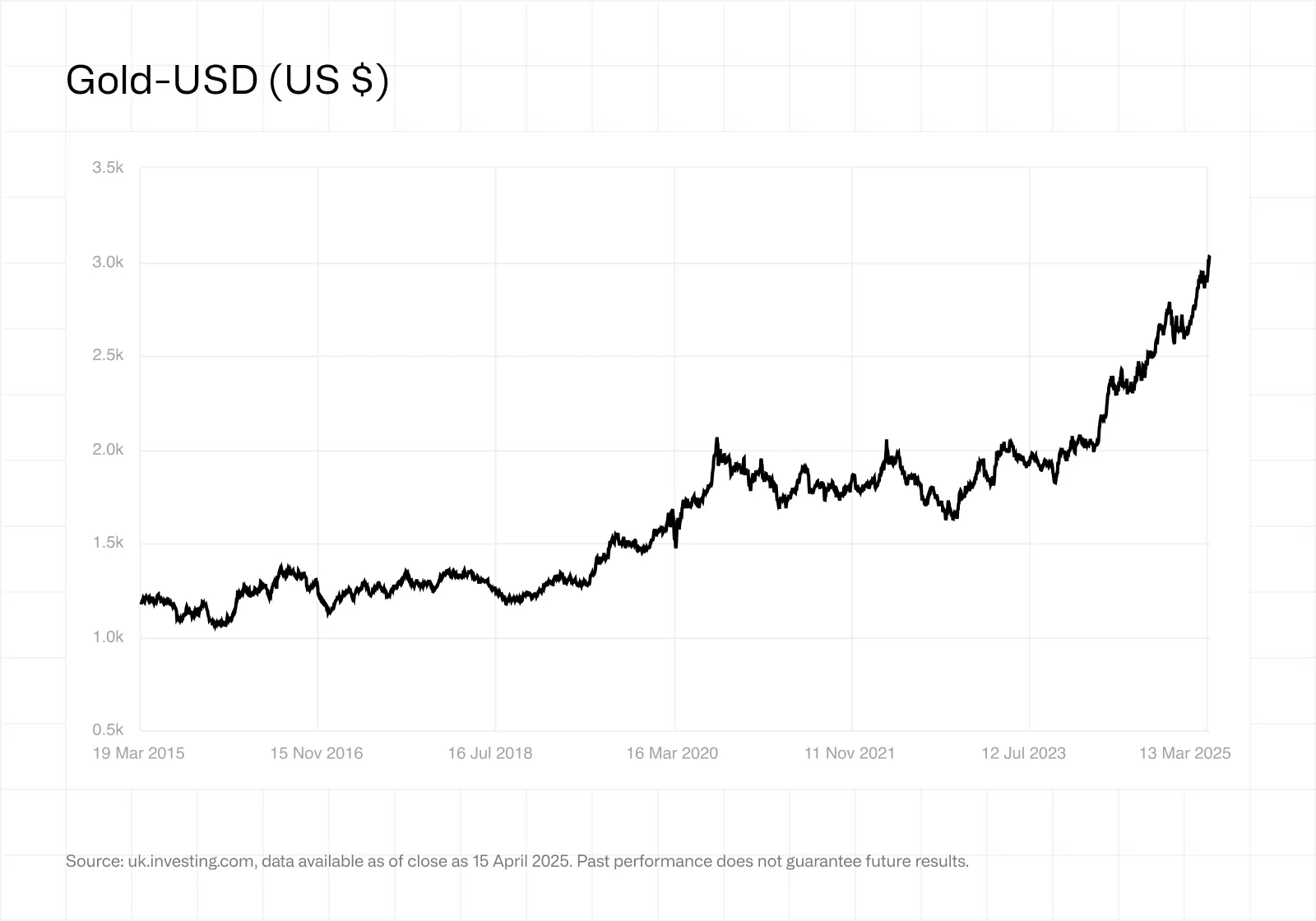Amid persistent inflation, a weakening U.S. dollar, escalating trade wars, and waning trust in fiat currencies, the two assets most frequently discussed by investors today are gold and Bitcoin.
From fears of devaluation to the desire to preserve purchasing power, the race to become the “safe deposit box” of the 21st century has never been more intense.
Gold and Bitcoin Surge Amid Economic Uncertainty
Spot gold prices surpassed $3,500 per ounce on April 22, marking a new all-time high. JPMorgan forecasts the average gold price in 2025 to reach $3,675/oz, potentially climbing to $4,000/oz if high interest rates persist over an extended period.
Data shows that China now holds over 2,292 tonnes of gold, accounting for 6.5% of its total foreign exchange reserves. The People’s Bank of China has been steadily accumulating gold for several consecutive months, fueling global demand and accelerating the trend toward de-dollarization.
Bitcoin has also made significant strides. As of April 23, BTC is trading around $93,500, up more than 20% year-to-date. BlackRock’s spot ETF (IBIT) has attracted over $39.7 billion, becoming a key driver in Bitcoin’s institutional adoption. Investment giants such as Fidelity, ARK Invest, and VanEck are also increasing their BTC allocations in long-term portfolios.
When Cash Is No Longer Attractive
On a policy level, Bitcoin’s role has been elevated following U.S. President Donald Trump’s executive order to establish a “Strategic Bitcoin Reserve” under the Department of the Treasury. This move not only carries symbolic significance but also formalizes Bitcoin as part of the nation’s reserve assets. Meanwhile, gold continues to serve as a traditional pillar in central bank reserves worldwide.
According to data published by CoinShares on April 22, both gold and Bitcoin act as effective hedges against declining purchasing power in inflationary environments. Purchasing power, the ability of a unit of currency to buy goods and services has been consistently eroded amid rising inflation.
The Consumer Price Index (CPI) remains a common tool to measure this decline, and in such a landscape, gold and Bitcoin stand out as two of the few assets capable of preserving real value.
The report cites examples such as the United Kingdom, where the price of an 800-gram loaf of white bread has increased steadily since 1971, reflecting significant depreciation of the British pound. In Lebanon, where inflation peaked at 268% in April 2023, citizens were forced to abandon their local currency in favor of gold and Bitcoin to preserve purchasing power.
These are clear indicators that fiat currencies can fail in their role as a store of value, prompting a shift toward “hard assets.” Bitcoin has emerged as the digital successor to gold, particularly favored by younger generations and communities excluded from the traditional banking system.


Bread Price – Source: UK Investing
In practical terms, Bitcoin offers superior flexibility in storage and transfer. Unlike gold, Bitcoin stores in cold wallets and moves globally in minutes with low cost. A rapidly evolving security infrastructure, featuring multi-signature wallets, offline storage, and digital asset insurance is also strengthening its appeal.
Gold and Bitcoin: Which one is better?
Volatility – once seen as Bitcoin’s biggest drawback, is showing signs of stabilization. According to data from CoinMetrics and Bloomberg, Bitcoin’s 30-day volatility currently sits at 46%, its lowest level in two years. In contrast, the Gold Volatility Index (GVZ) is climbing to its highest point since the pandemic, signaling a resurgence in short-term speculation.
Long-term trends offer a compelling view: in terms of purchasing power growth since 2011, Bitcoin has significantly outperformed gold. However, due to its higher volatility, Bitcoin is better suited for long-term investors with a high risk appetite, while gold remains the defensive asset of choice.
Studies show Bitcoin and gold stay weakly or negatively correlated, especially in market stress. Newhedge data shows the Bitcoin and gold correlation rarely stays above 0.5, often turning negative.
Notably, during major Bitcoin drawdowns (2018, 2022) or sharp rallies (2021), its correlation with gold tends to decline. This evidence shows gold reacts to risk, while Bitcoin responds to growth and liquidity shifts.


Bitcoin and Gold correlation – Source: Newhedge
As a result, combining both assets in a portfolio can improve risk-adjusted returns through diversification. Investors increasingly view Bitcoin and gold as complementary assets in modern allocation strategies.
Major institutional players now favor dual exposure: gold for macroeconomic stability and Bitcoin for asymmetric growth potential. ARK Invest holds gold as a hedge and raised Bitcoin exposure to 12% in 2024.
SkyBridge Capital allocates 85% to gold and bonds and 15% to Bitcoin and tech stocks. This balanced strategy has proven effective amid increasingly volatile market cycles.


Conclusion
While gold offers consistency and trust built over millennia, Bitcoin provides adaptability and scalability for a digital future. Historical performance, institutional momentum, and evolving monetary policies suggest that the optimal strategy for investors is not to pick sides but to diversify intelligently. Allocating a portion of one’s portfolio to both assets, balancing gold’s defensive strength with Bitcoin’s growth trajectory, may offer the best chance at preserving and expanding wealth in the 21st century.
Read more: Day Trading Crypto: A Beginner’s Guide
 Bitcoin
Bitcoin  Ethereum
Ethereum  Tether
Tether  XRP
XRP  USDC
USDC  Wrapped SOL
Wrapped SOL  TRON
TRON  Lido Staked Ether
Lido Staked Ether  Dogecoin
Dogecoin  Figure Heloc
Figure Heloc  Cardano
Cardano  WhiteBIT Coin
WhiteBIT Coin  Bitcoin Cash
Bitcoin Cash  Wrapped stETH
Wrapped stETH  Wrapped Bitcoin
Wrapped Bitcoin  Wrapped eETH
Wrapped eETH  USDS
USDS  Binance Bridged USDT (BNB Smart Chain)
Binance Bridged USDT (BNB Smart Chain)  LEO Token
LEO Token  Chainlink
Chainlink  Zcash
Zcash  Monero
Monero  WETH
WETH  Coinbase Wrapped BTC
Coinbase Wrapped BTC  Stellar
Stellar  Ethena USDe
Ethena USDe  Hyperliquid
Hyperliquid  Canton
Canton  Litecoin
Litecoin  Avalanche
Avalanche  Sui
Sui  Hedera
Hedera  USDT0
USDT0  Dai
Dai  Shiba Inu
Shiba Inu  sUSDS
sUSDS  Toncoin
Toncoin  World Liberty Financial
World Liberty Financial  PayPal USD
PayPal USD  Uniswap
Uniswap  Cronos
Cronos  Ethena Staked USDe
Ethena Staked USDe  USD1
USD1  Mantle
Mantle  Polkadot
Polkadot  Rain
Rain  MemeCore
MemeCore  Bitget Token
Bitget Token 



